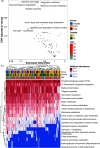Eubacterium rectale is a potential marker of altered gut microbiota in psoriasis and psoriatic arthritis
- PMID: 38441468
- PMCID: PMC10986482
- DOI: 10.1128/spectrum.01154-23
Eubacterium rectale is a potential marker of altered gut microbiota in psoriasis and psoriatic arthritis
Abstract
Previous studies have profiled the gut microbiota among psoriatic patients compared to that among healthy individuals. However, a comprehensive understanding of the magnitude, direction, and detailed compositional and functional profiles remains limited. Additionally, research exploring the gut microbiota in the context of both plaque psoriasis (PsO) and psoriatic arthritis (PsA) is lacking. To assess the taxonomic and functional characteristics of the gut microbiota in PsO and PsA patients and investigate potential links between the gut microbiota and disease pathogenesis. We collected fecal samples from 70 psoriatic patients (44 PsO and 26 PsA) and 25 age- and gender-matched healthy controls (HC) and employed deep metagenomic sequencing to characterize their gut microbiota. We noted significant alternations in the gut microbiota compositions of both PsO and PsA patients compared to those of HC. Despite limited effect sizes in alpha diversity (12.3% reduction of microbial richness but unchanged evenness in psoriatic patients) and beta diversity (disease accounts for 3.5% of total variations), we consistently observed substantial reductions of Eubacterium rectale in both PsO and PsA patients, with PsA patients exhibiting even lower levels of E. rectale than PsO patients. Additionally, two Alistipes species were also depleted in psoriatic patients. These microorganisms are known to play crucial roles in carbohydrate metabolism pathways, mainly producing short-chain fatty acids with anti-inflammatory effects. Overall, our observations supplemented the profiling of altered gut microbiota in patients with PsO and PsA at the species level and described a link between the dominant short-chain fatty acid-producing bacterial species and systemic immunity in psoriatic patients.
Importance: In this observational clinical study with sufficient sample size and metagenomic sequencing to profile the gut microbiota, we identified consistent signals of the depleted abundance of Eubacterium rectale and related functional genes among psoriatic patients, including those with psoriatic arthritis. E. rectale may serve as an ecologically important functional unit in the gut microbiota, holding potential as a diagnostic marker and target for therapeutic interventions to achieve lasting effects. Our findings provide comprehensive gut microbiota profiling in psoriasis, resolving previous contradictions and generating new hypotheses for further investigation. These insights may significantly impact psoriasis management and related conditions.
Keywords: Eubacterium rectale; gut microbiota; metagenomics; psoriasis; psoriatic arthritis.
Conflict of interest statement
Authors including Yue Xiao, Yiyi Wang, Yuanxia Gu, Xingli Zhou, and Wei Li declare that they have no conflict of interest. Authors including Bangzhuo Tong, Xiaochen Yin, Yan Kou, Yan Tan, and Jincheng Wang report a patent for CN202211736100.1 pending (Shenzhen Xbiome Biotech Co. Ltd.).
Figures



Similar articles
-
Decreased bacterial diversity characterizes the altered gut microbiota in patients with psoriatic arthritis, resembling dysbiosis in inflammatory bowel disease.Arthritis Rheumatol. 2015 Jan;67(1):128-39. doi: 10.1002/art.38892. Arthritis Rheumatol. 2015. PMID: 25319745 Free PMC article.
-
Altered gut microbiota and metabolite profiles in community-acquired pneumonia: a metagenomic and metabolomic study.Microbiol Spectr. 2025 Apr;13(4):e0263924. doi: 10.1128/spectrum.02639-24. Epub 2025 Mar 10. Microbiol Spectr. 2025. PMID: 40062854 Free PMC article.
-
Deciphering Gut Microbiota Dysbiosis and Corresponding Genetic and Metabolic Dysregulation in Psoriasis Patients Using Metagenomics Sequencing.Front Cell Infect Microbiol. 2021 Apr 1;11:605825. doi: 10.3389/fcimb.2021.605825. eCollection 2021. Front Cell Infect Microbiol. 2021. PMID: 33869074 Free PMC article.
-
The gut microbiome in psoriasis and psoriatic arthritis.Best Pract Res Clin Rheumatol. 2019 Dec;33(6):101494. doi: 10.1016/j.berh.2020.101494. Epub 2020 Apr 29. Best Pract Res Clin Rheumatol. 2019. PMID: 32360228 Review.
-
Impact of Gut Bacterial Metabolites on Psoriasis and Psoriatic Arthritis: Current Status and Future Perspectives.J Invest Dermatol. 2023 Sep;143(9):1657-1666. doi: 10.1016/j.jid.2023.05.012. Epub 2023 Jul 9. J Invest Dermatol. 2023. PMID: 37422760 Review.
Cited by
-
Beyond the dichotomy: understanding the overlap between atopic dermatitis and psoriasis.Front Immunol. 2025 Feb 10;16:1541776. doi: 10.3389/fimmu.2025.1541776. eCollection 2025. Front Immunol. 2025. PMID: 39995673 Free PMC article. Review.
-
Gut dysbiosis narrative in psoriasis: matched-pair approach identifies only subtle shifts correlated with elevated fecal calprotectin.Microbiol Spectr. 2025 Jan 7;13(1):e0138224. doi: 10.1128/spectrum.01382-24. Epub 2024 Dec 10. Microbiol Spectr. 2025. PMID: 39656003 Free PMC article.
-
Emerging role of gut microbiota in autoimmune diseases.Front Immunol. 2024 May 3;15:1365554. doi: 10.3389/fimmu.2024.1365554. eCollection 2024. Front Immunol. 2024. PMID: 38765017 Free PMC article. Review.
-
The efficacy and safety of probiotics in the adjuvant treatment of psoriasis: a systematic review and meta-analysis of randomized controlled trials.Front Med (Lausanne). 2024 Sep 6;11:1448626. doi: 10.3389/fmed.2024.1448626. eCollection 2024. Front Med (Lausanne). 2024. PMID: 39328313 Free PMC article.
-
From gut to joint: the protective impact of Eubacterium rectale on rheumatoid arthritis.Front Immunol. 2025 Jul 25;16:1607804. doi: 10.3389/fimmu.2025.1607804. eCollection 2025. Front Immunol. 2025. PMID: 40787457 Free PMC article.
References
-
- Scher JU, Ubeda C, Artacho A, Attur M, Isaac S, Reddy SM, Marmon S, Neimann A, Brusca S, Patel T, Manasson J, Pamer EG, Littman DR, Abramson SB. 2015. Decreased bacterial diversity characterizes the altered gut microbiota in patients with psoriatic arthritis, resembling dysbiosis in inflammatory bowel disease. Arthritis Rheumatol 67:128–139. doi:10.1002/art.38892 - DOI - PMC - PubMed
Publication types
MeSH terms
Grants and funding
LinkOut - more resources
Full Text Sources
Medical
Research Materials
Miscellaneous

